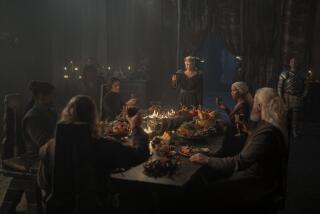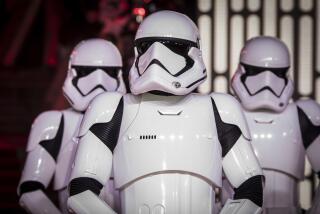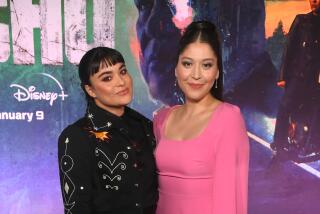A Semi- Fantastic Voyage
Other fans might have pranced in velvet capes, or blasted Led Zeppelin’s J.R.R. Tolkien-inspired “Ramble On” as they waited in line for the opening of “The Lord of the Rings: The Fellowship of the Ring.”
At Pasadena’s Pacific Theater Wednesday, one intense band of devotees, Tolkien Society and Mythopoeic Society members, brought heads full of ambivalence. And they left the same way.
“On one hand, we’re excited to see the movie,” said Lynn Maudlin, a 10-year veteran of the Mythopoeic Society’s Council of Stewards, who organized the outing for the eight fans, who are mostly in their 40s and 50s. On the other, she said, she came expecting disappointment. “It’s the movie in your head you want to see.”
The film is of particular interest to members of the England-based Tolkien Society and its U.S. members, as well as devotes of the international Mythopoeic Society, devoted to the study of fantasy and mythic literature, notably Tolkien, C.S. Lewis and Charles Williams. It has about 500 members in the U.S.
Diana Glyer, a Tolkien scholar, said that in adapting the complex, layered universe of Tolkien’s novel into a film, director Peter Jackson was like an Olympic diver missing a difficult dive by a quarter inch.
“Overall, it’s a pretty impressive accomplishment,” she said. “The goodness of the good aspects outweighs the problems. But I’m frustrated because the problems are so glaring, they make it not an enjoyable film for me to watch.” If she were a judge, she said she’d give it a 7 out of 10.
The three-hour film is one of the best-reviewed movies of the year and was nominated Thursday for a best dramatic film Golden Globe award. It took in an estimated $18.2 million its first day in theaters; by the end of Thursday, the film had earned $27.9 million.
Though their criticism is not surprising, the Tolkien fans did not consider themselves hard-core purists. They are people, frequently grown-up honor students, who have spent decades reading and rereading Tolkien books. They go to conferences, where they listen to scholarly papers and play around with Tolkien-inspired games and languages. They can tell you dwarfs are shorter than humans, but taller than hobbits, that humans and elves can intermarry, that elves are immortal.
The really hard-core fans, they said, are those who can actually speak Elvish, who make an annual ceremony of rereading the “Lord of the Rings,” who have committed all the volumes, the appendices and the books about the books to memory, and collectors and “completists” who must have a copy of every printed version.
The group who saw the film Wednesday had complaints ranging from the beginning--too expository--to the end--Aragorn the prince, not Frodo the Hobbit, should make the decisions--and from the general to the specific.
Several were concerned that the good characters, happy places and beautiful landscapes, the very things they loved about the book, were overshadowed by darkness and evil characters. Rivendell, the home of the elves, seemed desolate, said Shannon Riojas.
Mike Glyer, Diana’s husband, said the character of Galadriel (played by Cate Blanchett) was “totally alien” to the positive, colorful character he had expected and was painful to watch. The depiction of Lothlorien, the home of Galadriel, upset Diana: “That should have been very green, very natural.” She said she needed a rest from the technology and the fighting.
In the first book of the “Lord of the Rings” there’s almost no fighting, but in the movie, the battle scenes were relentless, she said. “I needed breaks,” Glyer said. “I felt that all the way through the whole film as if someone was hitting me upside the head, saying, ‘This is monumental. Are you paying attention here?’ The problem is, when there are really huge moments, you can’t appreciate them.”
The movie, for instance, describes a lengthy battle with a troll in the pit of Moria, just before the death of the fellowship’s moral leader, Gandalf. “The proportions are wrong,” she said. “You can’t react strongly.”
Lee Speth said, “Something of the inner child in me would have wanted a different ending.” The movie showed the creature Golum shadowing Frodo in Moria, but then dropped him. “In the book there was a bit of churning in the water behind [Frodo as he rowed off.] It was sort of like the crocodile following Capt. Hook.”
The language worked best when it was taken from the book, most of the group agreed. “Let’s go hunt some Orc’ didn’t really cut it for me,” Maudlin said.
On the positive side, they liked the cinematography and Elijah Wood’s Frodo, particularly the ethereal quality of his face. “Some moments were very well done, better than my imagination would have done,” said Diana Glyer, referring to the death of Boromear, and epic look of the pit of Moria.
Speth said he had had more hopes than fears for the film. “We’re pretty old and staid at this point,” he said of Tolkien fans. “We’re hoping this movie will attract some young blood.” Glyer, who teaches English at Azusa Pacific University, said she was worried the movie would change the way the students picture the characters and places in their heads.
“For me, reading ‘The Lord of the Rings’ is about the beauty of the language and how well Tolkien uses words to describe things to create moments and moods. From the very first time I read the book, when the hobbits were hungry, strangely so was I. When it was naptime for the hobbits, I felt like maybe I should take a nap.”
*
Times staff writer Vivian LeTran contributed to this story.
More to Read
Only good movies
Get the Indie Focus newsletter, Mark Olsen's weekly guide to the world of cinema.
You may occasionally receive promotional content from the Los Angeles Times.










